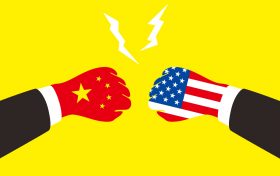Huawei Questions Dog Components Markets

This week brought more drama to the U.S.-China trade relationship. The U.S. Dept. of Justice (DOJ) revealed a criminal investigation of Huawei. The DOJ is investigating whether Huawei violated U.S. sanctions related to Iran -- an issue that last week resulted in the U.S. blacklisting Chinese vendor ZTE, threatening billions in revenue for U.S. companies that supply technology to the multi-billion dollar communications equipment provider.
The Huawei news generated a lot of discussion among market participants this week. I spoke to many investment analysts as well as industry participants, most of whom would only speak on background. The conclusion appears to be that this has opened up more questions than answers. Quantifying the impact on chip and components suppliers is difficult, as witnessed by their volatile reactions to the news (mostly down). Overall, this did not add to the optimism around components suppliers with large Chinese exposure such as optical components vendors such as Acacia (ACIA), Oclaro (OCLR), and Lumentum (LITE), as well as mobile phone chip providers such as Qualcomm (QCOM), Skyworks (SWKS), and Qorvo (QRVO).
What's complicated is that this news came not only just after the announcement of new actions against ZTE, but also as investors were expecting a rebound in Chinese demand in components, especially in the optical arena. Optical components stocks have been hit hard over the past year after Chinese demand did not live up to expectations. On the flip side, the actions against Chinese firms may have benefits for U.S. and other Western companies such as Ciena (CIEN), Infinera (INFN), and Nokia (NOK), which have a chance to take advantage of the investigations and trade actions.
Some Wall St. analysts say the Huawei investigation's timing is unclear, and will only add uncertainty to the market.
"Unclear what the outcome of DOJ's Huawei investigation will be," wrote MKM analyst Michael Genovese in an investment note earlier in the week, when the news was announced on Wednesday. "We believe that criminal investigations typically take a long time to complete (at least a year), and it is unclear exactly when this investigation began."
Genovese notes that optical component companies with high revenue exposure to Huawei include Neophotonics (NPTN) at approximately 40% of sales, Lumentum at 17%, Oclaro at 13%-15%, and Finisar (FNSR) at roughly 10%. A Bloomberg article also points out that mobile chip providers such as Skyworks and Qorvo also have potentially high exposure. All of the share prices of these companies have been under pressure this week on the news.
What's more important, however, is the shifting relations between China and what this means in the long term. The Chinese markets are huge and have recently provided the bulk of growth in areas such as communications networks, optical, and chips. The U.S. government is not just taking actions at the Treasury, Commerce, and DOJ level, but also in U.S. Congress. Lawmakers and regulators have been taking action against China in a variety of ways and are looking at other areas such as government procurement rules for doing business with China.
How will China respond? It's interesting that an article in the South China Morning Post indicates that Chinese companies, especially Huawei, are increasingly looking at development of their internal sourcing so that they rely less on U.S. technology. Huawei has been heading in this direction by developing its own internal chip capabilities -- the company talked abut developing its own artificial intelligence chips at its analyst conference last week, as reported here on Futuriom.
There will be a lot of pressure on both sides of the Pacific to reach an amicable resolution to the conflicts. In the long run, everybody knows that U.S. companies want access to Chinese markets and that Chinese vendors are also dependent on many U.S. components and chip technologies. The global supply chain is a reality. These market dynamics are not going to change overnight.
Will the recent actions cause the Chinese vendors to increasingly build internal capabilities for components and chips? That is likely, but the breadth of supply they derive from U.S. chip companies is still large and the Chinese equipment vendors still remain dependent on many facets of U.S. technology to deliver their products. This will continue for years.
The bottom line is the resolution of these trade tensions will take a long time to resolve. However, most market participants and investors point to a history of resolution to such trade dispute, so a negotiated settlement for both Huawei and ZTE is expected rather than an all-out impasse. Watch this space closely.




